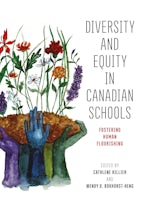AcknowledgementsIntroduction: Educating for Diversity and Human Flourishing: A Conceptual Model
Part I: Education Policy: A History and Application of Multicultural and Critical Ideologies in Canada
Chapter 1: The Evolution of Canadian Multiculturalism: Policy and Legal Considerations
Chapter 2: Critical Race Theory in Canadian Educational Praxis
Part II: Ethnicity and Race: Incorporating a Pedagogy of Justice, Liberation, and Care
Chapter 3: Cosmopolitan Education and Racial Justice: The Implications of Martha Nussbaum's Philosophy of Education for Forging a Common National Memory in Canada
Chapter 4: Supporting Students to Thrive, Grow, and Flourish: Embracing Their Literate Lives as Liberatory Praxis
Chapter 5: Towards Strengths-Based Culturally Responsive Teaching of Refugee Students with Interrupted Formal Education
Part III: Socioeconomic Status: Understanding and Responding to Systemic Barriers to Foster Human Flourishing
Chapter 6: Socioeconomic Status and Children's Education in Canada: The Importance of Aspirations in Flourishing
Chapter 7: Pedagogical Strategies for Equity and Inclusion: Addressing Low Socioeconomic Status Students in the Canadian Classroom
Part IV: Gender and Sexual Diversity: Supporting Students' Identity as Important to Human Flourishing
Chapter 8: Gender and Sexuality in Education: Critical Considerations
Chapter 9: Disruptive Stories: Straight Teachers Navigating Queer Allyship in Ontario Schools
Part V: Indigenous Education: Remembering the Past, Acknowledging the Present, Fostering Communities of Flourishing
Chapter 10: Tribal Critical Race Theory, Wâhkôhtowin, and Decolonizing Canadian Education
Chapter 11: Fostering Wellness and Redefining Success for All Students through Indigenous Perspectives
Part VI: Language: Policies and Practices to Support Linguistic Inclusion and Flourishing
Chapter 12: Globalization, Decolonization, and the Diversity of Linguistic Identities: A Review of Language Policies and Practices in Canadian K to 12 Education
Chapter 13: Inclusive Instructional Design within Language Education: Principles and Practices for the Modern Canadian Classroom
Part VII: Religion: Understanding, Inclusion, and Flourishing of Religious Diversity
Chapter 14: Framing Religious Diversity in the Canadian Classroom
Chapter 15: Broadening Understandings of Religion to Support Student Flourishing
Part VIII: Disability: Nurturing Belonging and Flourishing Among Students with Disabilities
Chapter 16: Lived Disability Experience in Canadian Schooling: Essential Knowledge for Fostering Disabled Flourishing
Chapter 17: Schools as Polis: Fostering Participation and Belonging of Children with Disabilities in Classrooms and Schools
Part IX: Geography: The Importance of Location in Supporting Students and Teachers
Chapter 18: The Landscape of Education Inequalities in Northern and Rural Locations in Canada
Chapter 19: Encountering Rural Narrative/Fiction in Teacher Education: Toward a Conversation
Part X: Intersectionality: Teaching the Whole Child in Consideration of Human Flourishing
Chapter 20: Implicit Inequities in School Practices: Interdisciplinary Perspectives
Chapter 21: The Things We Carry: Human Flourishing for Students and Educators through the Equity Backpack Project
Conclusion: Pedagogy for Flourishing: Preparing and Equipping the Educator
Author Biographies

